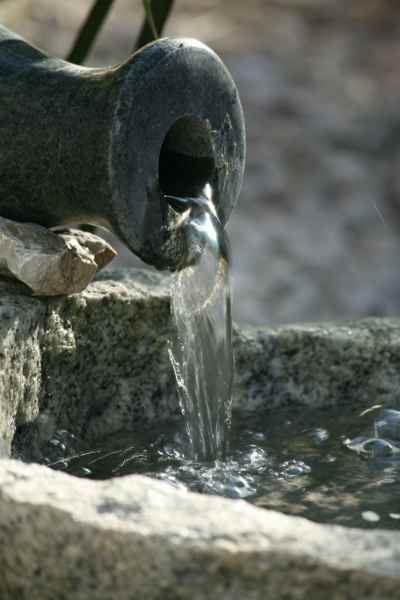Primitive Water Storage And Collection

Clean drinking water isn't the only reason to collect and store water. Other reasons include hygiene and gardening. Water for gardening obviously doesn't need to be pure, but having it stored can save untold amounts of work collecting and transporting large amounts invariably uphill.
First let's tackle drinking water. Rainwater is going to be clean and safe to drink until it starts touching stuff and flowing across the ground. So collecting rainwater for drinking, cooking and many other purposes such as brushing your teeth is without a doubt going to be something you will be tasked with when trying to establish a homestead.
Collecting rainwater can be as simple as putting out containers when it rains. Rainfall is not going to completely fill a container you put out though. So in addition to each container you will also need something to funnel more rainwater into your containers. This can be multiple things for multiple containers or one or three big things such as a roof or rooves. This can also be something as simple as a really large leaf, a roof, or anything inbetween.
 What to use for containers? For simplicity sake, I would suggest making a large number of clay jars with removable lids. Clay pottery is one of the easiest primitive containers to make. To learn more about making clay pottery check out this link here. Make Clay Pottery
What to use for containers? For simplicity sake, I would suggest making a large number of clay jars with removable lids. Clay pottery is one of the easiest primitive containers to make. To learn more about making clay pottery check out this link here. Make Clay Pottery
Of course when in a pinch you can use natural objects to get you by until you have made enough containers to get you from rain event to rain event. Coconut shells or the classic natural container. Of course, most people will not have access to coconuts. However, with a little bit of whittling at night you can carve out makeshift cups and bowls. These will also come in handy later when they are replaced by a more practical permanent storage vessel. Leaves and scavenged containers or rocks with bowl like indentations can also serve as temporary collection vessels.
But back to storage containers you can make for more advanced water storage needs. Glass is another great option. But I wouldn't even attempt glass making until you have advanced enough so that if you fail, the productiveless time spent failing doesn't jeopordize your survival. Glass making info can be found here. Glass Making
Another option for making a storage container will be metal. Information on metal blacksmithing can be found here. Blacksmithing Again, This is a skill that you shouldn't be attempting on your first month or likely not your first year of self reliance simply because free time and energy will be in short supply.
Concrete is another great option for water storage, but yet again, you are unlikely to be able to make concrete early on but is something to look into when your home has advanced somewhat. Concrete making info from scratch can be found here. Concrete
The roof on any structure you make can serve as a means to get more water into your containers when it rains. Ideal materials would be things such as bamboo, switch cane, sheet metal, wood, leather, concrete or clay tiles.
Care must be taken once water is collected to prevent contamination. Lids/tops to cover your containers will be a must.
But what about water for other purposes such as gardens. Well if you have a garden of any appreciable size, then a few jars of collected rainwater will be essentially useless. For gardens/farms you will need to have a means to more water uphill for irrigation or a pond to store water that is uphill from the crops. And this is where a pond is going to be needed.
Digging a pond by hand is a daunting task. Digging a pond that doesn't hold water is horrifying. Here are a few tips on pond building.
- Dig deep holes and confirm that they hold water before digging a complete pond.
- Sandy soils will not hold water. Clay soil is what you need.
- If the soil is not high in clay, you can bring in clay to line the pond bottom instead.
- Your pond will need to have an area uphill from it that drains into it to keep it supplied with water.
- In low wet regions such as south Louisiana you can often get by by simply digging the pond and allow the high water table to keep it full.
- Be wary of your ponds dam washing out. The pond should not be relied on to prevent runoff from washing your crops away.
- A spillway on your pond should direct water away from your garden.
- Do not allow trees on an earth pond dam. Dead roots will rot and create leaks.
To summarize. Make clay jars and clay curved clay tiles for drinking water.
